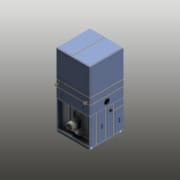What exactly does a splitter silencer do?
What are the benefits of a splitter silencer?
How does it work and in which areas of application is it particularly useful?
Loud blowers, fans, ventilation or extraction systems pollute your working environment? In this case, baffle silencers – also known as sound attenuation baffles – are the ideal solution. They effectively reduce the noise level in ventilation and air-conditioning systems.
How do splitter silencers work?
Sound attenuation briefly explained
Sound waves hit an absorbent material. Friction and vibrations in the material convert the sound energy into heat. The result: the intensity of the sound waves decreases.
Construction and materials
Splitter silencers consist of a rectangular or cylindrical housing. Inside are panels arranged in parallel.
These panels – or baffles – are filled with sound-absorbing material, usually mineral wool. The flanges on both sides close off the housing.
The sound-permeated air flows between the gaps in the baffles. The sound waves penetrate the absorbent material and are absorbed.
Incidentally, the more attenuation is required, the narrower the gap.
Splitter silencers often consist of:
- Galvanized sheet steel: The standard, suitable for many applications.
- Stainless steel: For demanding environments and high temperatures.
- Aluminum: For lightweight applications.
The surface often has an abrasion-resistant glass silk cover or is covered with perforated sheet metal.
Areas of application for splitter silencers
Industrial applications
Splitter silencers are used in many areas of industry. In hall heating / ventilation and air conditioning technology, they dampen fan noise and airflow noise. Rectangular ventilation ducts are particularly suitable for the use of baffle silencers.
Baffle silencers are also often found in ventilation systems with chimney outlets and with fans in ductwork.
Applications in the aerospace industry
Aircraft engines are extremely loud. To protect personnel, splitter silencers are therefore also used in the development and maintenance of aircraft engines. They are also used in aerodynamic research facilities and rocket launch sites.
Applications in the automotive industry
Sound-absorbing baffles are also used in the automotive industry. In production facilities, they reduce noise from machines and paint shops. In engine test benches and wind tunnels, they enable precise measurements as they minimize background noise.
Selecting the right splitter silencer
Factors for consideration
Place of use: The dimensions of the device and the suitable material vary depending on the available space and place of use.
Extreme conditions require special materials. Special surface treatments may also be required.
Type of noise: The type of noise and the desired insulation performance influence the design of the sound attenuation baffle.
They determine the arrangement, thickness and length of the baffles, as well as the absorption material.
Pressure loss: Excessive pressure loss can impair the entire system. It also drives up energy costs. Pressure loss can be reduced by using a frame with a streamlined profile.
Fire protection: The sound insulation baffle should meet the requirements of building material class A1 (non-combustible) in accordance with DIN 4102 and EN 13501.
Air velocities: Some baffle silencers have an upper limit of 12 m/s, while others can handle velocities of up to 20 m/s and more.
Recommendations for different areas of application
Baffles made of galvanized sheet steel are ideal for standard ventilation systems. They are cost-effective, lightweight and suitable for most buildings.
For industrial applications with high requirements, heavy industrial designs with robust materials and constructions are preferred.
The design can also vary here: A staggered arrangement of baffles allows for better attenuation at high frequencies.
If space is limited, split versions in width, height or length are useful. Compact designs allow a lot of noise to be insulated even in the smallest of spaces.
Splitter silencers that meet the requirements of VDI 6022 are necessary for special hygienic requirements.
Maintenance and care of splitter silencers
Maintain the longevity and reliability of splitter silencers through regular maintenance: Check your splitter silencers regularly for dirt and damage.
In the case of heavy soiling, thorough cleaning according to the manufacturer’s instructions is sufficient.
Particular attention should be paid to rust protection, especially in damp environments and with steel splitters.
And last but not least: test the damping performance regularly. Measure the noise level with a sound level meter and check the absorption material for wear.
Conclusion: The splitter silencer as an efficient solution for noise problems
The sound-insulating baffles from LK Metall meet the highest demands for all ventilation and air-conditioning systems.
You can rely on our many years of expertise.
We can help you create a quieter and more efficient working environment. Contact us today and experience the benefits of our customized sound insulation solutions.










